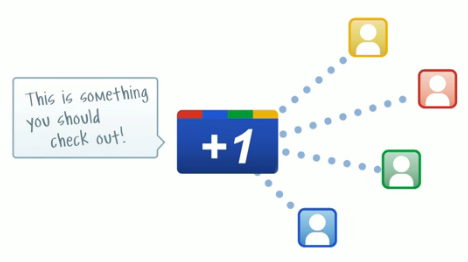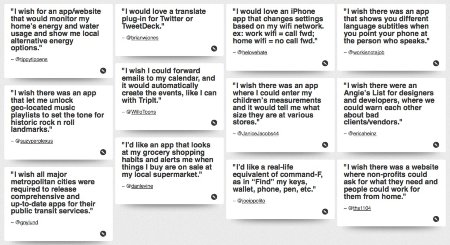Friday, September 20. 2013
Via MIT Technology Review
-----
By The Physics arXiv Blog
Sentiment analysis on the social web depends on how a person’s state of mind is expressed in words. Now a new database of the links between words and emotions could provide a better foundation for this kind of analysis.
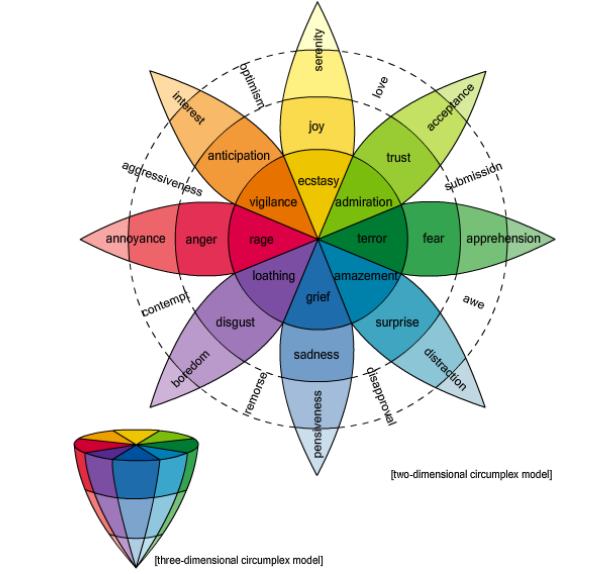
One of the buzzphrases associated with the social web is sentiment analysis. This is the ability to determine a person’s opinion or state of mind by analysing the words they post on Twitter, Facebook or some other medium.
Much has been promised with this method—the ability to measure satisfaction with politicians, movies and products; the ability to better manage customer relations; the ability to create dialogue for emotion-aware games; the ability to measure the flow of emotion in novels; and so on.
The idea is to entirely automate this process—to analyse the firehose of words produced by social websites using advanced data mining techniques to gauge sentiment on a vast scale.
But all this depends on how well we understand the emotion and polarity (whether negative or positive) that people associate with each word or combinations of words.
Today, Saif Mohammad and Peter Turney at the National Research Council Canada in Ottawa unveil a huge database of words and their associated emotions and polarity, which they have assembled quickly and inexpensively using Amazon’s crowdsourcing Mechanical Turk website. They say this crowdsourcing mechanism makes it possible to increase the size and quality of the database quickly and easily.
Most psychologists believe that there are essentially six basic emotions– joy, sadness, anger, fear, disgust, and surprise– or at most eight if you include trust and anticipation. So the task of any word-emotion lexicon is to determine how strongly a word is associated with each of these emotions.
One way to do this is to use a small group of experts to associate emotions with a set of words. One of the most famous databases, created in the 1960s and known as the General Inquirer database, has over 11,000 words labelled with 182 different tags, including some of the emotions that psychologist now think are the most basic.
A more modern database is the WordNet Affect Lexicon, which has a few hundred words tagged in this way. This used a small group of experts to manually tag a set of seed words with the basic emotions. The size of this database was then dramatically increased by automatically associating the same emotions with all the synonyms of these words.
One of the problems with these approaches is the sheer time it takes to compile a large database so Mohammad and Turney tried a different approach.
These guys selected about 10,000 words from an existing thesaurus and the lexicons described above and then created a set of five questions to ask about each word that would reveal the emotions and polarity associated with it. That’s a total of over 50,000 questions.
They then asked these questions to over 2000 people, or Turkers, on Amazon’s Mechanical Turk website, paying 4 cents for each set of properly answered questions.
The result is a comprehensive word-emotion lexicon for over 10,000 words or two-word phrases which they call EmoLex.
One important factor in this research is the quality of the answers that crowdsourcing gives. For example, some Turkers might answer at random or even deliberately enter wrong answers.
Mohammad and Turney have tackled this by inserting test questions that they use to judge whether or not the Turker is answering well. If not, all the data from that person is ignored.
They tested the quality of their database by comparing it to earlier ones created by experts and say it compares well. “We compared a subset of our lexicon with existing gold standard data to show that the annotations obtained are indeed of high quality,” they say.
This approach has significant potential for the future. Mohammad and Turney say it should be straightforward to increase the size of the date database and at the same technique can be easily adapted to create similar lexicons in other languages. And all this can be done very cheaply—they spent $2100 on Mechanical Turk in this work.
The bottom line is that sentiment analysis can only ever be as good as the database on which it relies. With EmoLex, analysts have a new tool for their box of tricks.
Ref: arxiv.org/abs/1308.6297: Crowdsourcing a Word-Emotion Association Lexicon.
Tuesday, March 06. 2012
Via MIT Technology Review
-----
Pinwheel, a new site created by Flickr cofounder Caterina Fake, lets users post virtual notes anywhere.
By Rachel Metz
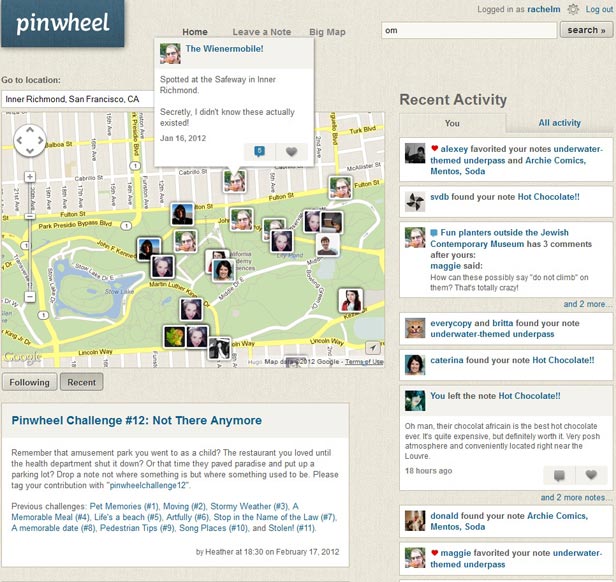
You've probably left plenty of notes for people in the past—on a kitchen counter, slipped through the slots of a locker, or even scrawled on a bathroom wall. But what if you could leave notes anywhere in the world for anyone to discover, and find ones posted by others?
That's the idea behind Pinwheel, the latest startup from Flickr cofounder Caterina Fake. Though the social site only recently emerged in a private beta testing phase, it's gaining buzz for its simple premise: letting people annotate a map with notes on any topic that can be shared with others.
Fake, a fan of the GPS treasure-hunting activity known as geocaching, says Pinwheel merges several ideas and inspirations. She first began toying with the idea of leaving virtual notes for others to find back in 1999, but the technology wasn't there to support it. And after cofounding Flickr in 2004, she was inspired by users of that site who would annotate satellite maps of their hometowns with notes about various locations. Now, as smart phones have become incredibly popular and location-based apps like Foursquare have blossomed, Fake is confident that the timing is right for Pinwheel, too.
The site's main page—which you need an invitation to see—shows a stream of recently posted notes, and users can browse a map there to check out public notes, leave notes, or search for notes or users.
Navigating the main map is like exploring a visual mash-up of a travel and restaurant guide peppered with memories of first kisses and apartments, event notices, historical facts, and more. There are burger and sushi recommendations, notes about good places to watch the sun set, and tags marking a long-gone movie theater and candy store. One user has been using Pinwheel to log crimes—including the kidnapping and return of Banana Sam, a squirrel monkey belonging to the San Francisco Zoo (now safely returned)—while another is recording historic facts in various cities.
"To me, when you are creating social software, the most exciting part of it is when people start using your tools for things you hadn't expected," Fake says.
At the moment, there is no Pinwheel smart-phone app to help you leave notes on the fly, so users simply log on to the Pinwheel website to do so (there is a mobile site, and Fake says an iPhone app is forthcoming).
Notes can be set as visible to any site user, or just to certain people that you've chosen to follow on the site. Currently, notes can only include text or photos, but Fake says this could eventually expand to audio or video clips as well.
As of early last week, only about 1,000 people were using the site, but Fake says tens of thousands of people have requested invites, and Pinwheel is now sending those out.
Jason Hong, an associate professor at Carnegie Mellon University who studies mobile social technology, sees interesting possibilities for Pinwheel as well as several challenges, including how to gain a critical mass of users and content given the popularity of existing tools like Yelp, Foursquare, and Twitter. "People are still struggling with what, exactly, they're using this for," he says.
Regardless, investors are confident Pinwheel is on to something. The site recently raised $7.5 million in a Series A funding round led by Redpoint Ventures, which added to the $2 million in funding Pinwheel had previously raised. Fake's past success helped, too—photo-sharing site Flickr sold to Yahoo in 2005 and the recommendation engine Hunch, which she also cofounded, sold to eBay in 2011, both for undisclosed amounts.
And, unlike many other Silicon Valley startups, Pinwheel does have a business model: it plans to make money by allowing sponsored notes, something that it's already testing out.
Redpoint partner Geoff Yang says he liked the notion of bringing an offline activity like leaving notes onto the Web, and he sees the site as the combination of social, mobile, and local trends. "I thought the idea was really interesting—the notion that Pinwheel, in many respects, makes places come alive," he says.
Copyright Technology Review 2012.
Personal comment:
An idea (and technology) of annotating the physical world with digital (geolocalized) notes that comes again.
Tuesday, November 22. 2011
Via GeekOSystem via Computed·Blg
-----

A new installation at the Amsterdam Foam gallery by Erik Kessels takes a literal look at the digital deluge of photos online by printing out 24 hours worth of uploads to Flickr. The result is rooms filled with over 1,000,000 printed photos, piled up against the walls.
There’s a sense of waste and a maddening disorganization to it all, both of which are apparently intentional. According to Creative Review, Kessels said of his own project:
“We’re exposed to an overload of images nowadays,” says Kessels. “This glut is in large part the result of image-sharing sites like Flickr, networking sites like Facebook, and picture-based search engines. Their content mingles public and private, with the very personal being openly and un-selfconsciously displayed. By printing all the images uploaded in a 24-hour period, I visualise the feeling of drowning in representations of other peoples’ experiences.”
Humbling, and certainly thought provoking, Kessel’s work challenges the notion that everything can and should be shared, which has become fundamental to the modern web. Then again, perhaps it’s only wasteful and overwhelming when you print all the pictures and divorce them from their original context.

 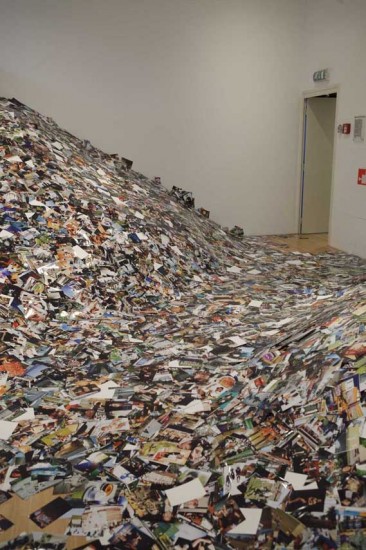
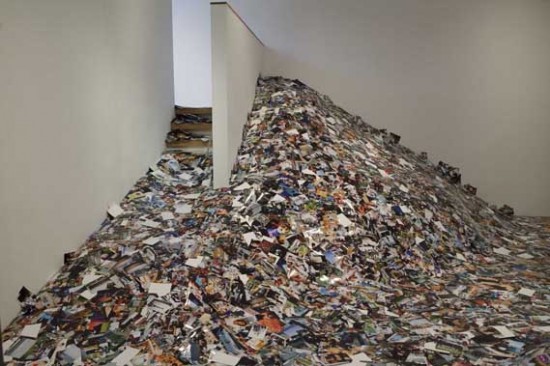
Tuesday, October 04. 2011
Via The Funambulist
-----

In front of the incredible silence of the media about the Occupying Wall Street Movement -the New York Times had a very small article in the NY section about it five days ago bias(ly) entitled “Gunning for Wall Street, With Faulty Aim“- I feel obliged to talk about this extremely interesting micro-society existing right in between Ground Zero and Wall Street in New York. About this very eloquent silence in the press, you might want to read the excellent article by Gaston Gordillo on the never disappointing Critical Legal Thinking. Silence is indeed their best weapon to fight against their fear of this movement increasing.
The Police should know that its brutality is only bringing more reasons to resist the injustice that capitalism develops in its implementation and that now reach summit in the social inequalities. Nevertheless, the movement voluntarily remains absolutely non-violent and leaderless. Organization is the key notion here. A computer lab on site is relaying information directly on the Internet, a kitchen supplies food for the American indignants, and several working group gather everyday to discuss and create how this micro-society could sustain itself in time and implement outreaching actions. At the end of each day, a General Assembly is gathered in which propositions and votes are effectuated in a very communal way characterized by the mean used by the indignants to make themselves heard: one person speaks and the rest who could hear repeat for the crowd further, in a very symbolic union of voices. Here again, the organization is impressive, especially as far as the domain of law is concerned with competent lawyers -some of the National Lawyers Guild- and other Cop-watchers who make sure that nobody is left alone if arrested.
Some people outside of the movement seem to blame the lack of specific demands. I, however, would claim that this group seems to have understood something about revolt: in fact, they create a micro-society, two blocks away from their antagonistic way of life’s embodiment (Wall Street), which implements de facto the democracy and the solidarity they are calling for as a model of society. Just like for the recent Egyptian Revolution, the moment of liberation is not so much the achievement (and therefore the termination) of the resistance movement but rather the process of this movement which forces people involved in it to develop a collective identity.
Here is the minute of the General Assembly I assisted to tonight
Here is a nice short film about and by the indignents
And even more importantly, the legal rights of the protester.











Friday, July 29. 2011
Via The Doors of Perception
-----
By Kristi

I have just received a quite extraordinary 736 page book called Lean Logic: A Dictionary For The Future and How To Survive It by the English ecologist David Fleming. The publisher describes it as a "community of essays". In my words it's half encyclopedia, half commonplace book, half a secular bible, half survival guide, half ... yes, that's a lot of halves, but I hope you get the picture. I have never encountered a book that is so hard to characacterise yet so hard, despite its weight, to put down.
The editors of Lean Logic, who have completed the project following Fleming's untimely death last year, say it's about "cooperative self-reliance in the face of great uncertainty". Well, yes. But today I have also read entries on nanotechnlogy, carnival, casuistry, multiculturalism, and the 'new domestication' - and I still have more than 1,000 entries to read. Waiting for me ahead are entries on road pricing, the vernacular, trust, resilience, the marshes of Iraq...
Lean Logic does not sugar-coat the challenges we face: an economy that destroys the very foundations upon which it depends; climate weirdness; ecological systems under stress; shocks to community and culture. Neither does the book suggest that there are easy solutions to these dilemmas. As Fleming has said, "large scale problems do not require large-scale solutions - they require small-scale solutions within a large-scale framework.
This is not a book to read from start to finish - although entry Number 1, on Abstraction, is engaging enough. Fleming defines abstraction as "Displacement of the particular - people, places, purpose - by general principle". Within a few lines Fleming introduces someone I never heard of, Alexander Herzen [1812-1870], as one of the first writers to "make the case for local detail, for pragmatic decision-making, for near-at-hand, for 'presence'. Fleming goes on to quote such other "scourges of abstraction" as Oliver Goldsmith, Montaigne, Joseph Conrad, and Matthew Arnold. And that's all on page one.
Among the incredibly useful passages I've already discovered are: a long text about 'resilience' and its multiple meanings; a clear account of Energy Decent Action Plans; an explanation of Harmonic Order; a comparative guide to barter through the ages; and a section on Lean Health.
Fleming was a co-founder of the UK Green Party, chair of the Soil Association, and active from its early days in the Transition Towns movement. He was one of the first people in the world to understand the implications for industrial civilzation of peak oil, and a good deal of the book is about energy in its many meanings. Fleming was the inventor - and advocate for more than a decade - of Tradeable Energy Quotas or TEQs. This energy rationing scheme is designed to share out fairly a nation's shrinking - as it must and will - energy/carbon budget, while allowing maximum freedom of choice over energy use.
But Lean Logic is neither a policy manifesto nor a dry technical guide. It's an incredibly nourishing cultural and scientific treasure trove. Its pages span ethics, science, culture, art, and history. The book's greatest strength, for this mesmerized reader, is the lightness with which it draws on knowledge from earlier periods of history, and from other cultures.
Lean Logic has been printed in a hardback first edition of just 500 copies, so get your order in quick.
Monday, May 23. 2011
Via OWNI.eu
-----
What do Pandora for music, Zite for news, or Amazon for shopping — along with many Silicon Valley startups I’m meeting these days — have in common?
• They are all offering the user a personalized experience by leveraging his/her social network.
• They also provide a social experience in line with every single user’s personal taste and identity.
Overall, there’s an increasing focus on the person and his/her environment versus the simple social media aspect.
These are only the premises of what I would call the persocial web — a new generation of digital products and services where personal and social dimensions melt together to put every person at the center of the game. The consequences of this trend will be extremely broad for the way we approach the Internet both from a sociological and business viewpoint.
A Socratic revolution
A similar kind of re-focus on the individual is physiological for humanity. It happened in the history of philosophy too, when Socrates put the man at the center of his intellectual quest after decades of philosophical thinking about nature, environment and physics.
In general, the fluctuation between holistic and individualistic eras is also very familiar to the history of ideas. Think about what happened in Europe from the 18th century to the 19th and beyond with the Age of Enlightment, followed by the Romantic Era and then by the Naturalistic movement. It’s just a dialectic and continuous evolution.
From the PC to the Social Media era. And beyond.
While these movements embrace more than one hundred years, my generation has already lived many of these ‘eras’ thanks to the time acceleration provided by information technologies.
The personal computer represents for people like me who are in their 30s the very first approach with computer technology. It was a very personal and sometimes solitary experience of writing and gaming. It was all about you. Well, you, the machine and the rest (games, floppy disks, your docs, etc).
Then the Internet came. First, we felt extremely powerless. We could interconnect and learn in the ‘cyberspace’ thanks to email, portals and chats. But we felt disoriented, until the point when Google figured out a way to have the individual navigating easily through all the amount of data, services and content that were out there in a more effective way than portals or email could do. But even at that stage, we lived in a personal web era. It was all about you, your Web browser and the rest. Beyond bi-lateral exchanges, multi-lateral interactions were difficult and sporadic.
Then Facebook disrupted that paradigm by creating a lasting and robust environment for sharing data and nurturing relationships. Our social life was, and is mirrored — sometimes diminished, sometimes augmented — on Facebook. It’s all about you, your social network and the rest.
I believe the next paradigm that is being formed today is going to envision the individual as the real center of a social environment (Facebook). Digital services and products will increasingly ‘talk’ to the individual in a personal way, by guessing his/her tastes and preferences in an intimate and closer relationship. Borrowing an expression from one of my professors at Stanford, Clifford Nass, they will become “adaptive and personalized systems“.
Leveraging what your social network (Facebook) or other random people (Amazon) do, read or buy to generate an experience that is more relevant to you is good. But designing a whole persocial experience is even better. That means taking into account countless personal data: sex, location, age, education, political and religious views, cultural tastes, all sort of affiliations, groups etc. and melting them with your social graph to offer a better user experience.
Facebook OpenGraph or Twitter API already enable such a personalization but its implementation has been so far more focused on real time and very much instant data (the feed of articles that my friends or people I follow read) than on more long-run information about my tastes (taking into account who I actually am, my background, sex, location etc.).
Towards a persocial news experience?
In the news industry, for instance, many are the news readers that are offering to improve the news experience by persocializing it. I tried to rate them by their personalization (1 to 5 points) and socialization (1 to 5 points) effort.
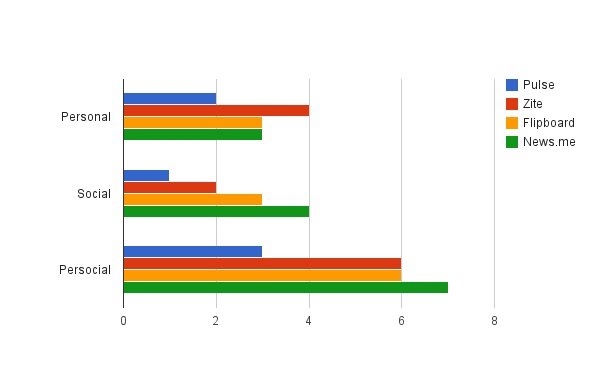
Thanks to its great feature on ‘what my friends are reading,’ News.me, developed by Betaworks and The New York Times, is so far the more persocial news reader, and also the only paid app among the ones we’re analyzing here. In reality, it offers a more social than personal experience. The best personalized features are so far provided by Zite, a Canadian news reader for the iPad, which recently received a ‘cease or desist’ letter from several U.S. publishers. While Flipboard is a fair trade-off in terms of persocialization, Pulse, conceived by smart Stanford students, is intentionally closer to a traditional and yet very clean news reader experience.
Overall, an iPad app that would combine the social features of News.me with the personalization of Zite, would probably be fully persocial.
In general, these new ventures are all part of an overall phenomenon that will reshape the way we consume and engage with web products and services. New privacy issues will raise of course but overall, thanks to persocialization, the web user will become a person again.
—
Photo Credits: Flicke CC Johan Larsson
Wednesday, April 20. 2011
Via @joelvacheron
-----
Documentary made after William Foote Whyte's seminal book "Street Corner Society".
Monday, April 04. 2011
Via Lift via Contemporary Spaces
-----
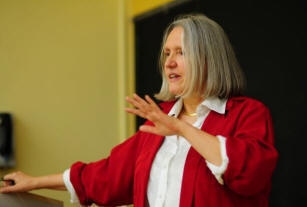
When one of the world's prominent thinker about global thinking takes a look at "smart cities", the result differs from what most of the Industry tends to say - and that's why we like it:
"I have long thought that all the major infrastructures in a city—from sewage to electricity and broadband—should be encased in transparent walls and floors at certain crossroads, such as bus stops or public squares. If you can actually see it all, you can get engaged. Today, when walls are pregnant with software, why not make this visible? (...) The challenge for intelligent cities is to urbanize the technologies they deploy, to make them responsive and available to the people whose lives they affect. Today, the tendency is to make them invisible, hiding them beneath platforms or behind walls—hence putting them in command rather than in dialogue with users. One effect will be to reduce the possibility that intelligent cities can promote open-source urbanism, and that is a pity. It will cut their lives short. They will become obsolete sooner. Urbanizing these intelligent cities would help them live longer because they would be open systems, subject to ongoing changes and innovations. After all, that ability to adapt is how our good old cities have outlived the rise and fall of kingdoms, republics, and corporations."
Cities are the places where Lift France '11's five key topics (OPEN, CARE, GREEN, LEARN, SLOW) will congregate. We're therefore especially happy that Saskia Sassen has agreed to give the opening speech.
Friday, April 01. 2011
Google has launched a close copy of Facebook's Like button that will crowdsource people's opinions to help the search engine know what's valuable online. Called +1, the button will appear on Web pages and alongside search results, enabling users to signal that they appreciated a piece of content. Google will track clicks of the button to hone search results, using clicks from your friends as a signal of what is most relevant to you.
The search company announced the new feature today, saying:
It's called +1—the digital shorthand for "this is pretty cool."
A YouTube video introduces the feature, which will be "slowly rolling out" on Google.com, at first for users of the English version. Google's new feature is very similar to one built by both rival Bing and search startup Blekko. Both use data from Facebook Like buttons to have your friends' opinions tune your search results.
However, your social network is something of a blind spot to Google, which doesn't have the same understanding of your social connections that Facebook does. Initially the +1s of your Google chat buddies and contacts will be used to "enhance" your results, the company says, while eventually +1s from your Twitter contacts might also be taken into account. At launch, though, +1 seems likely to be somewhat hamstrung by Google's lack of a detailed social "graph" for its users.
When Google previously tried to remedy that, it enraged people by guessing at whom its users were friends with from their e-mail activity, and pitching them into a copy of Twitter called Buzz. Coincidentally, the FTC today delivered its verdict on the debacle, labeling Google's behavior an example of "deceptive privacy practices."
Yet Google's hunger for a better understanding of your social network, and hence whose opinions it should use to tune your search results, is only going to be heightened by the launch of +1. Expect to see Google make renewed efforts to launch features and tools that capture social connections in coming months.
Personal comment:
With the actual hype word "crowdsourced", we can see a bigger trend coming on: the collaboration between a digital network of "universal computer machines" and a physical network of human brains to achieve tasks that humans can't do (as quickly) or that computers are not able to achieve (recaptcha paradigm). We see more and more network applications where computers either allow to organize a network of brains or literally rely on "organic brains" (a big and first exemple to my knowledge being the Mechanical Turk service by Amazon).
It is therefore a double augmentation: the human brain augmented by the networked computer(s) augmented by the brains. We can possibly see the same effects on contemporary space: the physical space augmented by the digital networked/mediated space augmented by the physical space...
Tuesday, March 29. 2011
Via GOOD
-----
by Alex Goldmark
Sure, it seems like there's an app for everything. But we're not quite there yet. There are still many practical problems with seemingly simple solutions that have yet to materialize, like this:
I wish someone would use the foursquare API to build a cab-sharing app to help you split a ride home at the end of the night.
Or this:
I wish there was a website where non-profits could ask for what they need and people could work for them from home.
Meet the Internet Wishlist, a "suggestion box for the future of technology." Composed of hopeful tweets from people around the world, the site ends up reading like a mini-blog of requests for mobile apps, basic grand dreaming, and tech-focused humor posts. All kidding aside, though, creator Amrit Richmond hopes the list will ultimately lead to a bit of demand-driven design.
To contribute, people post an idea on Twitter and include #theiwl in their tweet. Richmond then collects the most "forward thinking" onto the Wishlist website. (Full disclosure, she's a former Art Editor here at GOOD and now a creative strategist for nonprofits and start-ups.)
"I hope the project inspires entrepreneurs, developers and designers to innovate and build the products and features that people want," Richmond says. "I see so many startups try and solve problems that don't need solving. ... I wanted to uncover and show what kinds of day-to-day problems people have that they want technology to solve for them."
The list already has an active community of posters, who are quick to point out when there's already an app or website fulfilling a poster's wish. For instance, several commenters pointed out that people can already connect with nonprofits and do micro-volunteering from home through Sparked.
To see the full wishlist or subscribe, go here.
What would you ask for?
|
